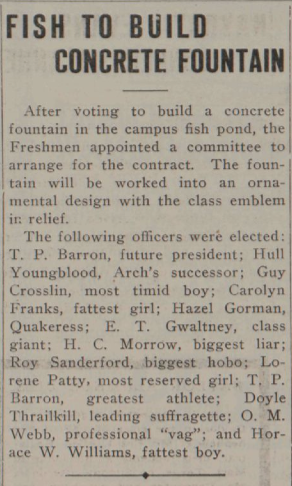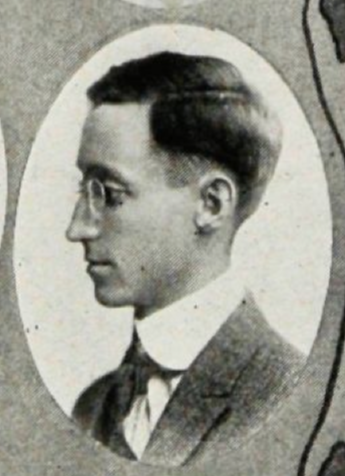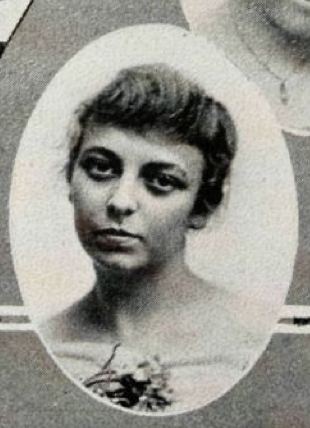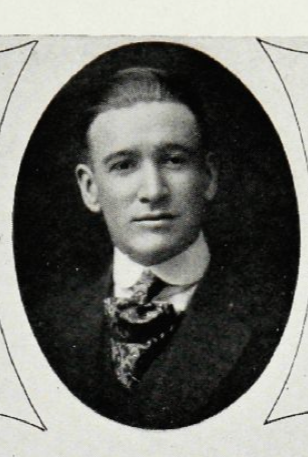Some people like to think that the proclivities of college students are a relatively recent occurrence. “They wear pajamas to class! They never look up from their cell phones! They give each other ridiculous nicknames! They have their laundry picked up by a service that washes and folds it before returning it to them!” And so on.
The corollary to this is that people also assume college students of a century ago were always serious, focused on academics, and learning how to become robber barons or doctors or famous theologians. (Also, the world was in black and white because color hadn’t been invented yet.)
If that’s been your mindset, prepare to clutch your pearls, because a look at a brief item from the March 18, 1915 Baylor Lariat reveals college students have been doing at least one of these – assigning ridiculous nicknames – since the days our great-grandparents roamed the campus.
This particular story was part of a “Freshman Edition” of the Lariat that was prominently stamped with the class’s graduating year:
 The fourth article featured above the fold is a two-paragraph story on a recent decision by the freshman class to memorialize itself in concrete.
The fourth article featured above the fold is a two-paragraph story on a recent decision by the freshman class to memorialize itself in concrete.
 In these two short paragraphs are revealed several insights into life on Baylor’s campus early in the last century. First off, the lead paragraph tells us that the class of 1918, like its contemporary classes of the era, was interested in leaving its mark on campus in the form of a permanent structure. (The other practice of painting one’s graduation year on the towers of Old Main was a splashier but less enduring option.) The proposed fountain for the class of 1918 was to be “an ornamental design with the class emblem in relief,” according to the story’s opening paragraph.
In these two short paragraphs are revealed several insights into life on Baylor’s campus early in the last century. First off, the lead paragraph tells us that the class of 1918, like its contemporary classes of the era, was interested in leaving its mark on campus in the form of a permanent structure. (The other practice of painting one’s graduation year on the towers of Old Main was a splashier but less enduring option.) The proposed fountain for the class of 1918 was to be “an ornamental design with the class emblem in relief,” according to the story’s opening paragraph.
The second paragraph reveals the quirky sense of humor on display by these early twentieth century Baylorites. A full list of “officers” and their “offices” includes:
T.P. Barron – future president
Hull Youngblood – Arch’s successor
Guy Crosslin – most timid boy
Carolyn Franks – fattest girl
Hazel Gorman – Quakeress
E.T. Gwaltney – class giant
H.C. Morrow – biggest liar
Roy Sanderford – biggest hobo
Lorene Patty – most reserved girl;
Doyle Thrailkill – leading suffragette
O.M. Webb – professional “vag” (vagabond)
Horace W. Williams – fattest boy
Some of these are pretty straightforward, if seemingly offensive to modern sensitivities. “Fattest girl,” “fattest boy” and “biggest hobo” are self-explanatory, but if you do a little digging you’ll find they’re much more likely to be satirical than true-to-life. For example, here’s a photo of “fattest boy” Horace W. Williams from the 1916 Round Up:
 And “biggest hobo” Roy Sanderford? He wound up serving in the Army in World War I and was listed as an honored alum in the 1918 Round Up. “Most timid boy” Guy Crosslin also served in the army (as a Lieutenant) and “class giant” E.T. Gwaltney was active in athletics, playing both basketball and tennis.
And “biggest hobo” Roy Sanderford? He wound up serving in the Army in World War I and was listed as an honored alum in the 1918 Round Up. “Most timid boy” Guy Crosslin also served in the army (as a Lieutenant) and “class giant” E.T. Gwaltney was active in athletics, playing both basketball and tennis.
Finally, “most reserved girl” Lorene Patty would go on to serve as secretary of the sophomore class in 1916.
 In that capacity, she would write the class’s history for the 1916 Round Up, concluding with these words:
In that capacity, she would write the class’s history for the 1916 Round Up, concluding with these words:
But the two most interesting for my money are “Arch’s successor” Hull Youngblood and “leading suffragette” Doyle Thrailkill. One would be part of a long-running tradition among the freshmen classes of the early 1900s and the other would propose an idea that became one of Baylor’s most recognized and longest-running icons.
First, Hull Youngblood, pictured here in all his cravat-ly glory in the 1915 Round Up:
 His title of “Arch’s successor” has to do with the story of a long-serving “handyman” on campus and one of Baylor’s earliest African American notables, Arch Long, pictured here in the 1932 Round Up:
His title of “Arch’s successor” has to do with the story of a long-serving “handyman” on campus and one of Baylor’s earliest African American notables, Arch Long, pictured here in the 1932 Round Up:
 Long began his 45 years of service to Baylor in 1892, working alongside his brother William. Long delivered coal, made repairs and generally served as a prototypical maintenance and facilities expert, all while exhibiting a great sense of humor and morals that were praised by Baylor president Pat Neff upon Long’s retirement in 1938. Long would die in 1952, his long service to the university earning him the status of “legend,” according to an article in the September 24, 1952 Lariat.
Long began his 45 years of service to Baylor in 1892, working alongside his brother William. Long delivered coal, made repairs and generally served as a prototypical maintenance and facilities expert, all while exhibiting a great sense of humor and morals that were praised by Baylor president Pat Neff upon Long’s retirement in 1938. Long would die in 1952, his long service to the university earning him the status of “legend,” according to an article in the September 24, 1952 Lariat.
For a number of years, during the first freshman class meeting each year, Arch’s name was put forward as a possible candidate for president, along with “candidates” like G.B. Hall (the name of a women’s dormitory) and Carroll Field (the athletic field on campus), the joke being that many of the freshmen wouldn’t know the latter two weren’t actually people, let alone members of the class. Ergo, Youngblood’s status as “Arch’s successor” seems to indicate he was likely to be put forward as a potential candidate for president of the class of 1918 at some point.
Doyle Thrailkill’s contribution to Baylor history is her putting forward the bear as Baylor’s official mascot. Replying to an appeal from Kit Roseborough in 1914, Thrailkill’s suggest of a bear won an overwhelming majority of the votes and would, of course, go on to become the official mascot. This process is best summed up by a brief recap in the 1928 Round Up:
 So the next time you think something a college student does is indicative of a modern trend toward dissolution, or you get the urge to shout, “Get off my lawn!” at a 20-year-old wearing earbuds and a fedora, remember that these same young people may go on to affect the history of your campus, your city or your nation in the years to come.
So the next time you think something a college student does is indicative of a modern trend toward dissolution, or you get the urge to shout, “Get off my lawn!” at a 20-year-old wearing earbuds and a fedora, remember that these same young people may go on to affect the history of your campus, your city or your nation in the years to come.
And if nothing else, you can rest easy in knowing that none of them will earn the title of “Quakeress,” so at least there’s that.
